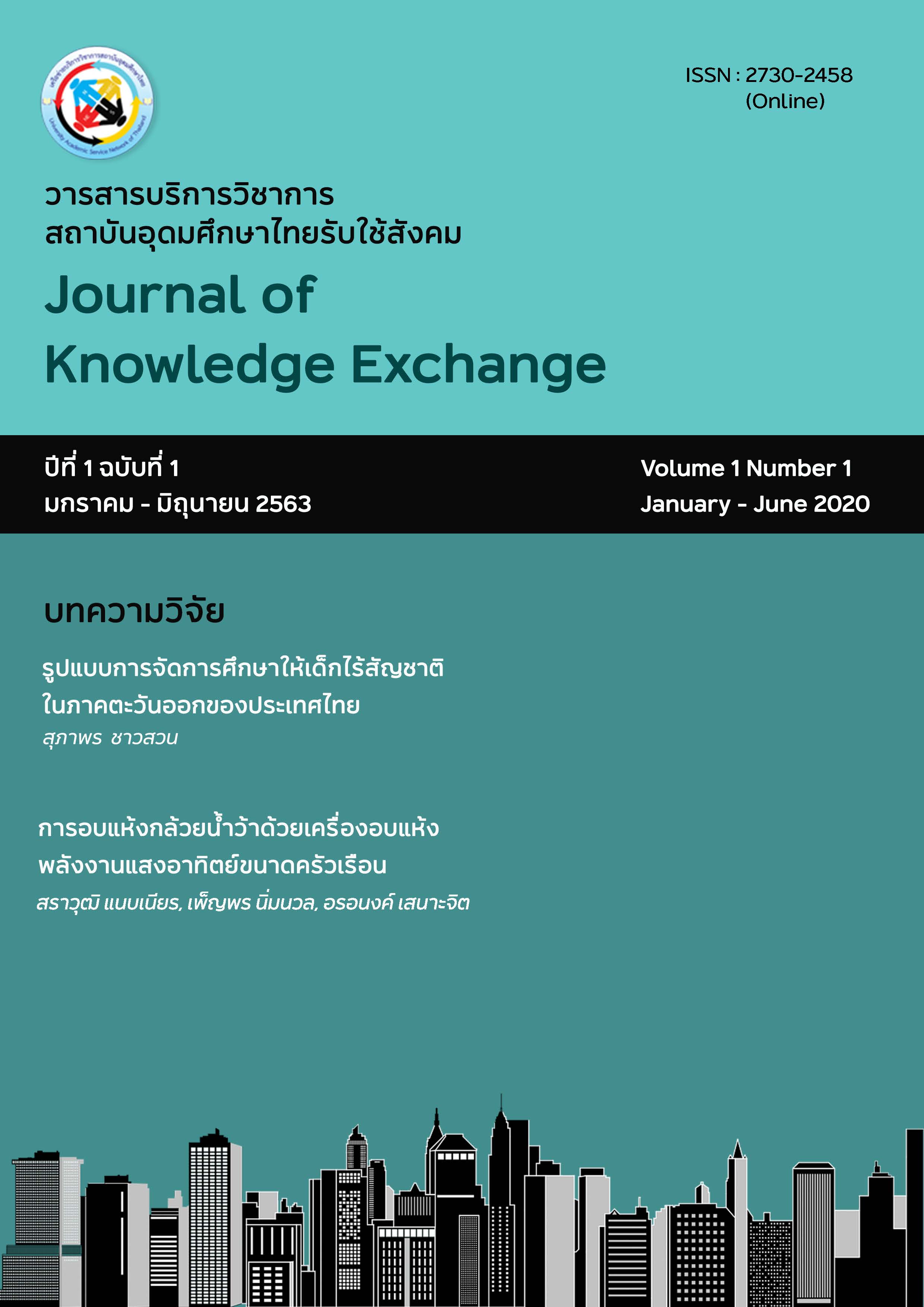การอบแห้งกล้วยน้ำว้าด้วยเครื่องอบแห้งพลังงานแสงอาทิตย์ขนาดครัวเรือน
Keywords:
เครื่องอบแห้งพลังงานแสงอาทิตย์, ความชื้นมาตรฐานเปียก, โพลีคาร์บอเนตAbstract
ในงานวิจัยนี้เป็นการทดลองการอบแห้งกล้วยน้ำว้าด้วยเครื่องอบแห้งพลังงานแสงอาทิตย์ขนาดครัวเรือน เครื่องอบแห้งพลังงานแสงอาทิตย์มีลักษณะเป็นรูปโค้งแบบพาราโบลาที่ทำจากแผ่นโพลีคาร์บอเนต พร้อมทั้งติดตั้งพัดลมจำนวน 2 ตัว ต่อเข้ากับแผงโซลาร์เซลล์ขนาด 10 วัตต์ เครื่องอบแห้งพลังงานแสงอาทิตย์นี้สามารถอบแห้งกล้วยน้ำว้าได้ครั้งละ 10 กิโลกรัม ซึ่งในขณะที่ทำการทดลองอบแห้งกล้วยนั้นอุณหภูมิภายในเครื่องอบแห้งพลังงานแสงอาทิตย์แปรค่าอยู่ในช่วง 33 ถึง 58 องศาเซลเซียส สามารถอบแห้งกล้วยที่มีความชื้นเริ่มต้น 73 (%wb) จนเหลือความชื้นเพียง 25 (%wb) ภายในระยะเวลาเพียง 4 วัน ในขณะเวลาเดียวกันก็ได้ทำการตากแห้งกล้วยตามธรรมชาติ ซึ่งเหลือความชื้นสุดท้าย 40 (%wb) โดยใช้ระยะเวลา 7-8 วัน เครื่องอบแห้งพลังงานแสงอาทิตย์นี้ใช้ระยะเวลาคืนทุน 1.2 ปี สำหรับกล้วยอบแห้งที่ได้นั้นมีคุณภาพที่ดีเนื่องจากมีการป้องกันแมลง ฝน และฝุ่นละออง ทำให้กล้วยอบแห้งที่ได้มีคุณภาพดีทั้งทางด้านสีและรสชาติ
References
ธีระพัฒน์ กู่วรรณรัตน์, วัชรินทร์ ดงบัง (2551). สมรรถนะของอุปกรณ์อบแห้งกุ้งโดยใช้พลังงาน แสงอาทิตย์, การประชุมวิชาการเครือข่ายพลังงานแห่งประเทศไทยครั้งที่ 4, โรงแรมโรสการ์เด้นริเวอร์ไซด์ สวนสามพราน จังหวัดนครปฐม
เสริม จันทร์ฉาย (2560). เทคโนโลยีอบแห้งด้วยพลังงานแสงอาทิตย์, นครปฐม: ตำราประกอบการสอน ภาควิชาฟิสิกส์ คณะวิทยาศาสตร์ มหาวิทยาลัยศิลปากร
Association of Official Analytical Chemists, (1970). Handbook of the AOAC/Association of Official Analytical Chemists. (3 rd ed.). Washington, DC.(s.n.).
Audsley, E., & Wheeler, J. (1978). The annual cost of machinery calculated using actual cash flows. Journal of Agricultural Engineering Research, 23(2), pp.189-201.
Duffie, J.A., Beckman, W.A. (1991). Solar engineering of thermal processes. John Wiley and Sons, New York.
Eltawil, M.A., Azam, M.M., Alghannam, A.O. (2018). Solar PV powered mixed-mode tunnel dryer for drying potato chips. Renewable Energy, vol. 116, pp. 594-605.
Erickson L.E. (1982). Recent developments in intermediate moisture foods. Journal of Food Protection, vol. 45(5), pp.484-491.
Fasoyiro, S., Hovingh, R., Gourama, H., Cutter, C. (2016). Change in water activity and fungal counts of maize-pigeon pea flour during storage utilizing various packaging materials. Procedia Engineering, vol. 159, pp.72-76.
Fudholi, A., Sopian, K., Yazdi, M.H., Ruslan, M.H., Gabbasa, M., Kazem, H.A. (2014). Performance analysis of solar drying system for red chili. Solar Energy, vol. 99. pp.47-54.
Janjai, S. (2012). A greenhouse type solar dryer for small-scale dried food industries: development and dissemination. International Journal Energy and Environment, vol. 3, pp. 383-98.
Janjai, S., Lakanaboonsong, J., Nunez, M., Thongsathitya, A. (2005). Development of a method for generating operational solar radiation maps from satellite data for satellite data for a tropical environment. Solar Energy, vol. 78, pp.739-751.
Nabnean, S., Janjai, S., Thepa, S., Sudaprasert, K., Songprakorp, R., Bala, B.K. (2016). Experimental performance of a new design of solar dryer for drying osmotically dehydrated cherry tomatoes. Renewable Energy, vol. 94, pp. 147-156.
Olagunju, O., Mchunu, N., Durand, N., Alter, P., Montet, D., Ijabadeniyi, O. (2018). Effect of milling, fermentation or roasting on water activity, fungal growth, and aflatoxin contamination of Bambara groundnut (Vigna subterranean (L.) Verdc). LWT – Food Science and Technology, vol. 98, pp.533-539.
Prakash, O., Kumar, A., Laguri, V. (2016). Performance of modified greenhouse dryer with thermal energy storage. Energy Reports, vol. 2, pp. 155-162.



